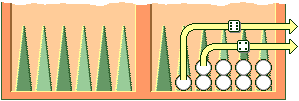Bearing Off - Once a player has moved all of his fifteen checkers into his home board, he may commence bearing off.
A player bears off a checker by rolling a number that corresponds to the point on which the checker resides, and then removing that checker from the board. Thus, rolling a 6 permits the player to remove a checker from the six point.
If there is no checker on the point indicated by the roll, the player must make a legal move using a checker on a higher-numbered point.
If there are no checkers on higher-numbered points, the player is permitted (and required) to remove a checker from the highest point on which one of his checkers resides. A player is under no obligation to bear off if he can make an otherwise legal move.
A player bears off a checker by rolling a number that corresponds to the point on which the checker resides, and then removing that checker from the board. Thus, rolling a 6 permits the player to remove a checker from the six point.
If there is no checker on the point indicated by the roll, the player must make a legal move using a checker on a higher-numbered point.
If there are no checkers on higher-numbered points, the player is permitted (and required) to remove a checker from the highest point on which one of his checkers resides. A player is under no obligation to bear off if he can make an otherwise legal move.

A player must have all of his active checkers in his home board in order to bear off. If a checker is hit during the bear-off process, the player must bring that checker back to his home board before continuing to bear off.
The first player to bear off all fifteen checkers wins the game.
Movement of the Checkers
